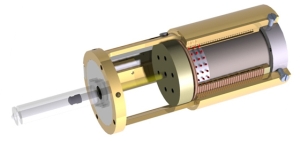Engineers at Massachusetts Institute of Technology have developed an alternative to hypodermic needles to deliver medications, but one that gives more control than most commercial jet injector devices. A description of the technology appears online in the journal Medical Engineering & Physics (paid subscription required).
The new device sends a tiny, high-pressure jet of medicine through the skin, as an alternative to a hypodermic needle. While there are devices on the market that do much the same thing, the MIT jet injector can be programmed to deliver a range of doses to various depths.
The device helps answer the need for alternatives to needles, for which people of all ages suffer phobias, and which can be an aid to people who need to give themselves injections. In addition, needle-stick injuries are a continuing hazard of health care work, exposing workers to risk of infectious diseases. A 2005 study estimates as many as 839 needlestick injuries are suffered per year for each 1,000 health care workers.
The team from MIT’s BioInstrumentation Lab, led by engineering professor Ian Hunter, devised a jet-injection system that delivers a range of doses to variable depths in a highly controlled manner. Hunter and colleagues built the injector around a small magnet surrounded by a coil of wire attached to a piston, inside an ampoule or vial of drugs.
When an electric current is applied, the current interacts with the magnetic field to produce a force that pushes the piston forward, ejecting the drug at very high pressure and velocity — at almost the speed of sound — through a nozzle in the vial. However, the speed of the coil and the velocity of the drug through the nozzle can be controlled by varying the amount of electric current applied.
Through testing, Hunter’s team generated pressure waveforms that modulate the current. They matched the waveforms to profiles that cover various skin types requiring different pressure levels to deliver adequate amounts of drugs to the desired depth.
“If I’m breaching a baby’s skin to deliver vaccine, I won’t need as much pressure as I would need to breach my skin,” says co-author Catherine Hogan. “We can tailor the pressure profile to be able to do that, and that’s the beauty of this device.”
The MIT team is developing a version of the device for transdermal delivery of drugs ordinarily found in powdered form. The device can be programmed to vibrate, which turns powder into a consistency like a liquid that can be delivered through the skin. This version of the device could be used to inject medications, such as some vaccines that must be refrigerated in liquid form, but can be transported without refrigeration as powder.
Hunter and Hogan tell more about the device in the following video.
- Eye Treatment Delivery Option to Syringe Being Developed
- Univ. Researchers Develop Dry Powder HPV Vaccine
* * *


 RSS - Posts
RSS - Posts
You must be logged in to post a comment.